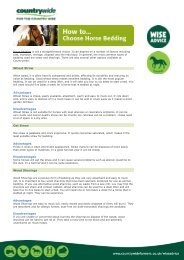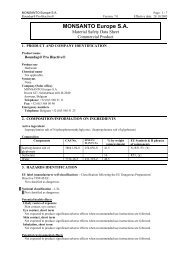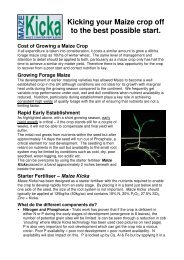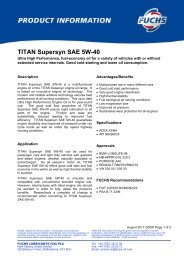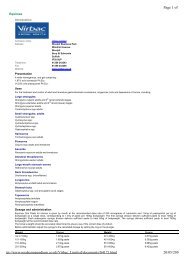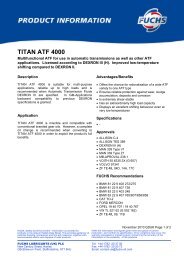TITAN ATF 4000_sds - Countrywide Farmers
TITAN ATF 4000_sds - Countrywide Farmers
TITAN ATF 4000_sds - Countrywide Farmers
- No tags were found...
Create successful ePaper yourself
Turn your PDF publications into a flip-book with our unique Google optimized e-Paper software.
DRSafety Data Sheetaccording to 1907/2006/EC, Article 31Page 1/5Printing date 21.07.2010 Revision: 21.07.20101 Identification of the substance/preparation and of the company/undertaking· Product details· Trade name: <strong>TITAN</strong> <strong>ATF</strong> <strong>4000</strong>· Article number: 600061784· Application of the substance / the preparation Transmission fluid· Manufacturer/Supplier:FUCHS LUBRICANTS (UK) PLC.New Century StreetHanleyStoke-on-Trent, Staffordshire, ST1 5HUUKEmergency telephone: (UK) 08701 200400e-mail: product.safety@fuchs-oil.com· Further information obtainable from: Product safety department.· Information in case of emergency: Emergency telephone: (UK) 08701 2004002 Hazards identification· Hazard description: Not applicable.· Information concerning particular hazards for human and environment:The product does not have to be labelled due to the calculation procedure of the "General Classificationguideline for preparations of the EU" in the latest valid version.· Classification system:The classification is according to the latest editions of the EU-lists, and extended by company and literaturedata.3 Composition/information on ingredients· Chemical characterization· Description: A blend of highly refined mineral oils with multifunctional additives.· Dangerous components:Methacrylate copolymer Xi; R 36 2.5-10%· Additional information: For the wording of the listed risk phrases refer to section 16.4 First aid measures· General information: No special measures required.· After inhalation: Supply fresh air; consult doctor in case of complaints.· After skin contact:Immediately wash with water and soap and rinse thoroughly.If skin irritation continues, consult a doctor.· After eye contact:Check for and remove any contact lenses.Rinse opened eye for several minutes under running water. Then consult a doctor.· After swallowing:Wash mouth out with waterDo not induce vomiting; call for medical help immediately.· Information for doctor:(Contd. on page 2)GB
DRSafety Data Sheetaccording to 1907/2006/EC, Article 31Page 2/5Printing date 21.07.2010 Revision: 21.07.2010Trade name: <strong>TITAN</strong> <strong>ATF</strong> <strong>4000</strong>(Contd. of page 1)High pressure injection injuries through the skin require prompt surgical intervention and possibly steroidtherapy, to minimise tissue damage and loss of function. Because entry wounds are small and do not reflectthe seriousness of the underlying damage, surgical exploration to determine the extent of involvement may benecessary. Local anaesthetics or hot soaks should be avoided because they can contribute to swelling,vasospasm and ischaemia. Prompt surgical decompression, debridement and evacuation of foreign materialshould be performed under general anaesthetics, and wide exploration is essential.5 Fire-fighting measures· Suitable extinguishing agents:CO2, powder or water spray. Fight larger fires with water spray or alcohol resistant foam.· For safety reasons unsuitable extinguishing agents: Water with full jet· Protective equipment:Wear self-contained respiratory protective device.Wear fully protective suit.6 Accidental release measures· Person-related safety precautions: Particular danger of slipping on leaked/spilled product.· Measures for environmental protection:Do not allow product to reach sewage system or any water course.Do not allow to penetrate the ground/soil.· Measures for cleaning/collecting:Absorb with liquid-binding material (sand, diatomite, acid binders, universal binders, sawdust).Send for recovery or disposal in suitable receptacles.· Additional information: No dangerous substances are released.7 Handling and storage· Handling:· Information for safe handling: Prevent formation of aerosols.· Information about fire - and explosion protection: No special measures required.· Storage:· Requirements to be met by storerooms and receptacles: Prevent any seepage into the ground.· Information about storage in one common storage facility: Store away from oxidizing agents.· Further information about storage conditions: Store in cool, dry conditions in well sealed receptacles.8 Exposure controls/personal protection· Additional information about design of technical facilities: No further data; see item 7.· Ingredients with limit values that require monitoring at the workplace:The product does not contain any relevant quantities of materials with critical values that have to be monitoredat the workplace.· Additional information: The lists valid during the making were used as basis.· Personal protective equipment:· General protective and hygienic measures:Wash hands before breaks and at the end of work.Do not carry product impregnated cleaning cloths in trouser pockets.Avoid close or long term contact with the skin.Do not eat, drink, smoke or sniff while working.Avoid contact with the eyes.Do not inhale gases / fumes / aerosols.· Respiratory protection: Not required.(Contd. on page 3)GB
DRSafety Data Sheetaccording to 1907/2006/EC, Article 31Page 3/5Printing date 21.07.2010 Revision: 21.07.2010Trade name: <strong>TITAN</strong> <strong>ATF</strong> <strong>4000</strong>(Contd. of page 2)· Protection of hands:The glove material has to be impermeable and resistant to the product/ the substance/ the preparation.Selection of the glove material on consideration of the penetration times, rates of diffusion and the degradation· Material of glovesThe selection of the suitable gloves does not only depend on the material, but also on further marks of qualityand varies from manufacturer to manufacturer. As the product is a preparation of several substances, theresistance of the glove material can not be calculated in advance and has therefore to be checked prior to theapplication.· Penetration time of glove materialThe exact break trough time has to be found out by the manufacturer of the protective gloves and has to beobserved.· Eye protection:Safety glassesGoggles recommended during refilling· Body protection: Oil resistant protective clothing9 Physical and chemical properties· General InformationForm:Colour:Odour:FluidBrownMineral-oil-like· Change in conditionMelting point/Melting range: Undetermined.Boiling point/Boiling range: Undetermined.· Flash point: > 100°C· Ignition temperature: >250°C· Self-igniting: Product is not selfigniting.· Danger of explosion: Product does not present an explosion hazard.· Density at 20°C: 0.86 g/cm³· Solubility in / Miscibility withwater:· Viscosity:Kinematic at 40°C:Not miscible or difficult to mix.39 cSt10 Stability and reactivity· Thermal decomposition / conditions to be avoided:No decomposition if used and stored according to specifications.· Materials to be avoided: Strong oxidising agents.· Dangerous reactions No dangerous reactions known.· Dangerous decomposition products: Carbon monoxide and carbon dioxide11 Toxicological information· Acute toxicity:· Primary irritant effect:· on the skin: No irritant effect.· on the eye: No irritating effect.· Sensitization: No sensitizing effects known.(Contd. on page 4)GB
DRSafety Data Sheetaccording to 1907/2006/EC, Article 31Page 4/5Printing date 21.07.2010 Revision: 21.07.2010Trade name: <strong>TITAN</strong> <strong>ATF</strong> <strong>4000</strong>(Contd. of page 3)· Additional toxicological information:The product is not subject to classification according to the calculation method of the General EUClassification Guidelines for Preparations as issued in the latest version.When used and handled according to specifications, the product does not have any harmful effects to ourexperience and the information provided to us.12 Ecological information· Information about elimination (persistence and degradability): Inherently biodegradable· Behaviour in environmental systems:· Mobility and bioaccumulation potential: Product is not expected to bioaccumulate.· Additional ecological information:· General notes: Generally not hazardous for water13 Disposal considerations· Product:· RecommendationContact waste processors for recycling information.Must not be disposed together with household garbage. Do not allow product to reach sewage system.Delivery of waste oil to offically authorized collectors only.Used, degraded or contaminated product may be classified as hazardous waste. Anyone classifying hazardouswaste and determining its fate must be qualified in accordance with state and international legislation.· European waste catalogue 13.01.10 (if used exclusively as a mineral based non-chlorinated hydraulic oil)· Uncleaned packaging:· Recommendation: Disposal must be made according to official regulations.14 Transport information· Land transport ADR/RID (cross-border)· ADR/RID class: -· Maritime transport IMDG:· IMDG Class: -· Marine pollutant: No· Air transport ICAO-TI and IATA-DGR:· ICAO/IATA Class: -· Transport/Additional information: Not dangerous according to the above specifications.15 Regulatory information· Labelling according to EU guidelines:Observe the general safety regulations when handling chemicals.The product is not subject to identification regulations under EU Directives and the Ordinance on HazardousMaterials (German GefStoffV).· Special labelling of certain preparations:Contains Alkoxylated long-chain alkyl amine. May produce an allergic reaction.Safety data sheet available for professional user on request.GB(Contd. on page 5)
DRSafety Data Sheetaccording to 1907/2006/EC, Article 31Page 5/5Printing date 21.07.2010 Revision: 21.07.2010Trade name: <strong>TITAN</strong> <strong>ATF</strong> <strong>4000</strong>(Contd. of page 4)16 Other informationThis information is based on our present knowledge. However, this shall not constitute a guarantee for anyspecific product features and shall not establish a legally valid contractual relationship.· Relevant R-phrases- The risk phrases shown below are for those component substances which are listed in section 3 and not forthe actual finished formulation.- Hazards are concentration dependent. Therefore for the actual hazard classification and risk/safety phrasesappropriate for the actual finished formulated product refer to section 15.36 Irritating to eyes.· Department issuing MSDS: Product safety department.· Contact: GORDON SHARPGB



